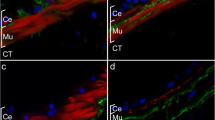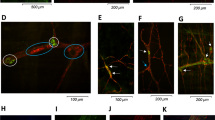Abstract
The distribution and ultrastructure of the interstitial cells of Cajal (ICC) has been examined in the small intestine of the frog Xenopus laevis, as the physiological significance of these cells remains obscure in amphibians and other lower vertebrates. The present study has revealed the existence of a special type of interstitial cell in the tunica muscularis of the small intestine of Xenopus; this cell is characterized by the presence of numerous caveolae, many small mitochondria, and the formation of intercellular connections with the same type of cell. Since these ultrastructural features are shared with mammalian ICC, the cells in the small intestine of Xenopus probably correspond to ICC. These cells also form close contacts with neighboring smooth muscle cells and with nerve varicosities containing accumulations of synaptic vesicles. These cellular networks are likely to be involved in the transmission of nerve impulses to muscle cells, as has been suggested for mammalian tissues. However, true gap junctions have not been detected; they occur neither between the same type of cells nor between the putative ICC and smooth muscle cells. The widespread distribution of ICC or equivalent cells in different groups of vertebrates, together with the conservation of their ultrastructural features, suggests that they differentiated early in vertebrate evolution to play key regulatory roles in gastrointestinal movement.






Similar content being viewed by others
References
Hanani M, Farrugia G, Komuro T (2005) Intercellular coupling of interstitial cells of Cajal in the digestive tract. Int Rev Cytol 242:249–282
Huizinga JD (2001) Physiology and pathophysiology of the interstitial cell of Cajal: from bench to bedside. II. Gastric motility: lessons from mutant mice on slow waves and innervation. Am J Physiol Gastrointest Liver Physiol 281:G1129–G1134
Imaizumi M, Hama K (1969) An electron microscopic study on the interstitial cells of the gizzard in the love-bird (Uroloncha domestica). Z Zellforsch Mikrosk Anat 97:351–357
Junquera C, Martinez-Ciriano C, Castiella T, Serrano P, Aisa J, Calvo E, Lahoz M (2001) Enteric plexus and interstitial cells of Cajal: interrelationship in the stomach of Podarcis hispanica (Reptilia). An ultrastructural study. Histol Histopathol 16:869–881
Komuro T, Zhou DS (1996) Anti-c-kit protein immunoreactive cells corresponding to the interstitial cells of Cajal in the guinea-pig small intestine. J Auton Nerv Syst 61:169–174
Komuro T, Seki K, Horiguchi K (1999) Ultrastructural characterization of the interstitial cells of Cajal. Arch Histol Cytol 62:295–316
Lecoin L, Gabella G, Le Douarin N (1996) Origin of the c-kit-positive interstitial cells in the avian bowel. Development 122:725–733
Maeda H, Yamagata A, Nishikawa S, Yoshinaga K, Kobayashi S, Nishi K, Nishikawa S (1992) Requirement of c-kit for development of intestinal pacemaker system. Development 116:369–375
Martinez-Ciriano C, Junquera C, Castiella T, Gomez-Barrena E, Aisa J, Blasco J (2000) Intrinsic innervation in the intestine of the lizard Podarcis hispanica. Histol Histopathol 15:1093–1105
Mitsui R, Komuro T (2002) Direct and indirect innervation of smooth muscle cells of rat stomach, with special reference to the interstitial cells of Cajal. Cell Tissue Res 309:219–227
Prosser CL (1995) Rhythmic electrical and mechanical activity in stomach of toad and frog. Am J Physiol 269:G386–G395
Reynhout JK, Duke GE (1999) Identification of interstitial cells of Cajal in the digestive tract of turkeys (Meleagris gallopavo). J Exp Zool 283:426–440
Sanders KM (1996) A case for interstitial cells of Cajal as pacemakers and mediators of neurotransmission in the gastrointestinal tract. Gastroenterology 111:492–515
Thuneberg L (1982) Interstitial cells of Cajal: intestinal pacemaker cells? Adv Anat Embryol Cell Biol 71:1–130
Thuneberg L, Peters S (2001) Toward a concept of stretch-coupling in smooth muscle. I. Anatomy of intestinal segmentation and sleeve contractions. Anat Rec 262:110–124
Wang XY, Sanders KM, Ward SM (1999) Intimate relationship between interstitial cells of Cajal and enteric nerves in the guinea-pig small intestine. Cell Tissue Res 295:247–256
Ward SM, Sanders KM (2001) Interstitial cells of Cajal: primary targets of enteric motor innervation. Anat Rec 262:125–135
Acknowledgements
The authors thank Dr. Peter Baluk, Cardiovascular Research Institute, University of California, San Francisco, USA, for reading the manuscript.
Author information
Authors and Affiliations
Corresponding author
Rights and permissions
About this article
Cite this article
Miyamoto-Kikuta, S., Komuro, T. Ultrastructural observations of the tunica muscularis in the small intestine of Xenopus laevis, with special reference to the interstitial cells of Cajal. Cell Tissue Res 328, 271–279 (2007). https://doi.org/10.1007/s00441-006-0363-5
Received:
Accepted:
Published:
Issue Date:
DOI: https://doi.org/10.1007/s00441-006-0363-5




